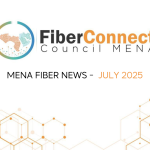pre-terminated fiber solutions. In reality, pre-terminated fiber is proven, effective, and field-tested—enabling faster deployments and lowering overall costs. Below are five common misconceptions—and the realities reshaping how operators approach fiber today.
Myth #1: Pre-terminated fiber is untested technology.
Reality: These connectivity solutions have been in the field for more than 20 years—and keep getting better.
Whether aerial or underground, hardened connectors designed to withstand UV, weather, and mechanical stress have proven reliability. Recent innovations (e.g., Evolv® with Pushlok® Technology) further improve size, performance, and ease of install.
Corning and others continue to refine form factors and installation methods. Field-installable connectors and new terminal options streamline deployment without compromising reliability.
Myth #2: Traditional splicing is more cost-effective.
Reality: Splicing may look cheaper at first glance, but pre-terminated often wins on total cost. Splicing is time-consuming, requires highly specialized labor, and adds equipment overhead. Pre-terminated designs cut install times dramatically—reducing months to weeks—and remove the need for specialized splice gear at subscriber turn-ups, accelerating ROI.
Operators pass and activate more subscribers with fewer touchpoints. Faster deployment equates to significant savings and earlier revenue recognition.
Myth #3: Pre-terminated solutions are unreliable and have more signal loss.
Reality: Connectors have proven field reliability. Corning alone has deployed 100M+ factory-terminated connectors globally with exceptionally low failure rates. Modern pre-terminated solutions deliver predictable losses as small as 0.25 dB or less—more than sufficient for most networks—and field-installable connectors have improved dramatically.
Predictable connector loss often beats the variability of field splices across different equipment and technician skill levels.
Myth #4: Connectivity is all or nothing.
Reality: Pre-terminated connectivity is a tool—not a mandate. Use it where it fits best based on labor, geography, density, and methods. Mix bulk cable and splicing with connectorized elements, or deploy selectively. The goal is a flexible architecture that adapts to future demand.

Myth #5: Pre-terminated fiber is harder to repair.
Reality: Repairs are as easy—or easier—than traditional splicing. Cables repair the same way whether connectors are present or not. If a terminal tail is damaged, splice it like any other cable. With a stubless terminal and intact cable, simply unplug the damaged terminal and plug in a new one. Design flexibility from day one ensures smoother upgrades and fixes.
Building repair paths into the design—slack, access points, and modular elements—keeps downtime low and service quality high.
Myths Busted
In a fast-moving fiber landscape, time and labor are strategic advantages. Pre-terminated solutions help operators scale faster, streamline resources, and bring revenue forward. Splicing remains vital—but the belief that connectorized solutions are inherently less reliable is, itself, a myth. |

Kara Mullaley
Published: August 7, 2025
Kara Mullaley serves as a Carrier Network Architect within Corning Optical Communications. Over her 25 years of experience in this industry, Kara has supported network operators large and small in the deployment of broadband networks worldwide. She is a subject matter expert on best practices for fiber deployment, architecture, and solutions to address tough deployment challenges, including meeting today’s rising bandwidth and application demands. She has delivered technical sessions at various FTTx conferences and has also been published in several trade publications.













Leave a comment
You must be logged in to post a comment.